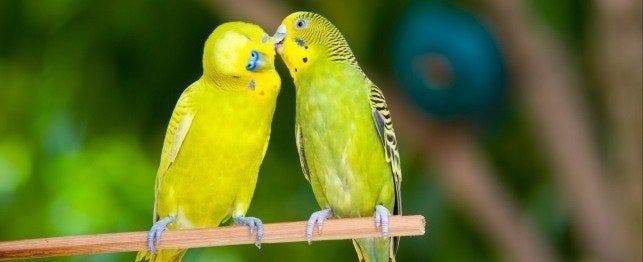
Is Your Bird in Love?
During mating season, males try to prove they’re the strongest, most virile specimens. They flap their wings, fan their tail feathers and belt out their most beautiful song – or their loudest squawk, if they’re not blessed with good pipes. Conveniently, mating season comes right after the annual molt, so males look their spiffiest.
After he’s piqued the female’s interest, the male will snuggle up to his beloved and preen her feathers. If he provides dinner for her – by regurgitating his food – he’s usually planning a romantic tryst. (Sound familiar?) The female will sometimes return that favor.
The Mating Dance
Mating itself is quick, but there are differences among the species. Sometimes the male stands on the female’s back; at other times, he just stands very close to her. The birds rub their vents (the opening where urine, feces and either semen or eggs leave the body) and semen is passed to the female. Mating occurs multiple times.
When it comes to settling down, different birds have different housing preferences. Some like large holes dug deep into the core of a tree. Others prefer tiny nests of moss and twigs lined with feathers. Some birds will even stick twigs in their wings, between the feathers, so they can carry more building material to the nest at one time. Research your bird’s species to find out what its housing preferences are.
Use Caution During Breeding Season
The female is usually the primary egg incubator, while the male stands guard outside the nest and brings food to his mate. Be cautious when handling your bird, or even going near the cage during breeding season because the bird will be primed with strong hormones that make it fiercely defensive. The worst bites inflicted by birds occur during mating season, and male birds may even injure their mates when trying to push them into the nest for safety.
Just because two birds have bonded, you shouldn’t assume they’re male and female. Homosexual pairs aren’t uncommon. In fact, birds that don’t have a mate can fall in love with an inanimate object or with their owner. A bird without a mate can bond with a toy or a human being as fiercely as with another bird; it will even go so far as to regurgitate on the object of its affection. Their snuggling and preening may seem endearing, but watch out. If you’re a male bird’s object of affection, he might try to assert his dominance or protect you from a perceived danger by trying to drive you back into the nest.
Occasionally, a single female will start laying eggs and continue until her calcium stores are depleted and her health is in danger. If your bird continually shows mating behaviors, you may need to increase her time in the dark and remove whatever toy she’s bonded to.
It’s sometimes necessary to take the bird to an avian veterinarian, who will inject her with HCG (human chorionic gonadotropin) to interrupt her breeding cycle.